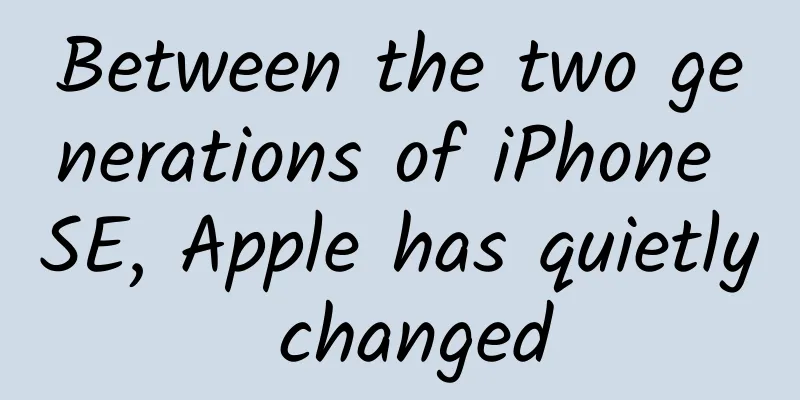Between the two generations of iPhone SE, Apple has quietly changed

|
After four years, Apple finally released the new iPhone SE. Just like four years ago, the iPhone SE is equipped with the most advanced chip (A13) and uses the industrial design and most of the components of the previous generation (iPhone 8). This is a model that focuses on "cost-effectiveness", with a starting price of 3,299 yuan, which is nearly half the price of the iPhone 11, which is also equipped with an A13 chip. The reaction of public opinion is almost the same, and people are paying great attention to SE. Apple has always positioned itself as a high-end brand and is used to making mobile phones priced above 5,000 yuan. When it comes to the price range of high-end Android phones, can it still show sufficient product competitiveness and brand appeal? Many questions have surfaced around the new iPhone SE: Why doesn't Apple redesign a full-screen solution? Why does it release a product that looks almost the same as the iPhone 6 six years ago when new designs and new features are emerging in the Android market? Most importantly, why would a product codenamed "SE" appear again in 2020? The first generation SE savior "failed" All of this starts from the first appearance of "SE". In 2016, Apple was facing its first "crisis" since the advent of the iPhone. The iPhone 6s series released in the fall of 2015 continued the design of the previous generation iPhone 6, with only one new feature, 3D Touch. This made a large number of iPhone users who were "chasing the latest" lack the motivation to change their phones. The strong "staying power" of the previous generation iPhone 6 became the "recoil" of 6s sales, especially in China. This impact was reflected in Apple's financial report for the second quarter of 2016. Apple's second fiscal quarter corresponds to the performance from January to March, which coincides with the Chinese New Year. The sales performance in Greater China during the Spring Festival will directly affect Apple's overall performance. In the second quarter of 2015, thanks to the success of iPhone 6, Apple's performance in Greater China increased by 71% year-on-year, and iPhone sales worldwide also increased by 57% year-on-year, which strongly boosted Apple's performance growth. However, in 2016, iPhone sales did not increase but decreased compared with the previous year, down 18% year-on-year. Many public opinions began to speak ill of Apple, believing that after nine years of development, the high-end market in which the iPhone is located is almost saturated and there is not much room for growth. At this time, on March 21, 2016, the first generation iPhone SE was released. SE was considered an attempt by Apple to enter the "mid-range market". It was equipped with the most advanced A9 chip at the time, and the performance burden of the 4-inch small screen was relatively low. SE had excellent performance. Four years later, it can still be upgraded to the latest iOS 13.4 system. However, iPhone SE did not “save” the iPhone business from its decline in 2016. After its release, iPhone sales continued to deteriorate in the third quarter of 2016. The low price of iPhone SE lowered the average selling price of iPhone, which amplified the sales gap and caused a 23% year-on-year decline. Obviously, the "SE" cannot help the iPhone business to gain more revenue, but it has achieved certain results in sales. iPhone sales in this quarter fell 15% year-on-year, which was narrower than the previous quarter. Since then, Apple's revenue report has quietly shown a trend of change. Why did the SE of "Wolf is Coming" come? After the iPhone market growth slowed down, Apple made two decisions. One was to expand the market and move down to the mid-range. The iPhone SE was an attempt by Apple. The other is to "raise prices" and explore higher-end price points. Therefore, a more extreme and more expensive high-end iPhone was launched. In the fall of 2017, Apple launched the iPhone X, which brought the price of the iPhone to the $1,000 level. This strategy was successful, and the iPhone X was very popular, directly leading the iPhone business to a single-quarter sales record of $61.1 billion, which has not been broken to this day. Apple continued to advance triumphantly, launching the XR and XS series at the end of 2018, and also launched the XS Max with a maximum price of up to $1,449. Today, the iPhone XR has become the digitally numbered iPhone 11, and Apple has completed the deployment of product lines in two price ranges: starting at 8,000 yuan (high-end) and starting at 5,000 yuan (mid-range). During this process, every spring, rumors of the upcoming release of iPhone SE are like the story of "The Boy Who Cried Wolf", whetting the appetite of users and the market. But it never appeared. The reason behind this is very simple. "SE" is not a regularly updated product line. Apple will only launch it when there is demand. The core of this demand is: the ceiling of iPhone sales. As the average price of iPhones continues to rise, iPhone sales have been falling year after year. In addition, Apple has placed great emphasis on iOS performance optimization in recent years. Many old phones have gained a "second life" after replacing batteries and updating the system. The frequency of users changing phones has begun to decrease, resulting in a group of iPhone 6s "nail households". Since 2019, Apple no longer discloses specific iPhone sales data in its financial reports, but based on the iPhone's sales volume and approximate average price, iPhone sales are still generally in a downward trend. In 2019, Apple finally changed its strategy again and began to abandon aggressive pricing. The price of iPhone 11 is lower than that of XR of the same level a year ago, which is even more attractive in the context of the rising prices of Android phones during the same period. So, six months later in the spring, when Apple needed more iPhone users, the iPhone SE finally returned. It was still the familiar formula: top-level chips, last-generation design, and even the price was the same as four years ago, starting at 3299. And the price didn’t increase with the increase in quantity, and the storage capacity increased from 16G four years ago to 64G now. But it doesn’t have a full screen, Face ID, or dual or triple cameras. Of course, “clearing inventory” and cost control are the main reasons, but for Apple, which is not so “tight”, it may be more concerned about whether the iPhone SE with A13 will in turn snatch users from the iPhone 11 and iPhone 11 Pro. Apple needs new users and loyal customers, but this cannot affect its other two "money-making" product lines. Apple needs entry-level users So why does Apple need so many iPhone users? Why did it sacrifice the average price of the iPhone and "lower its price" to move into the mid-range market to compete with Android for users? In fact, in the four years since the release of the first iPhone SE, Apple’s revenue structure has changed a lot. All the changes happened simultaneously. In 2019, Apple's overall revenue fell by only 2% against the backdrop of a 13.6% decline in iPhone sales throughout the year. This is because accessories and services are the two businesses that have led to new growth. AirPods and Apple Watch are selling better and better, maintaining a year-on-year growth of 30%-50% every quarter. New subscription services such as Apple News+, Apple TV+, Apple Card, and Apple Arcade also continue to drive software service revenue growth. These two businesses are built on the basis of hundreds of millions of active iPhone users. Smartphones are an increasingly saturated market. The fierce market competition makes it increasingly difficult for the iPhone product line to grow. Apple needs to find new revenue drivers. Today, wearable devices (earphones, watches, etc.) and services (video games, etc.) will become the most important sources of revenue growth. In the first quarter of 2020, Apple set a new quarterly revenue record after two years. This time, it no longer relied on the expensive iPhone, but a series of expanded experiences around the iPhone. Apple is no longer overly dependent on the iPhone itself. It does not need to push users to change phones more frequently or to push up iPhone prices. In the past few years, the proportion of iPhone sales revenue in Apple's total revenue has continued to decline. Apple needs more iPhone users to join this ecosystem. Therefore, the iPhone SE, as the best entry-level iPhone, has been put on the stage again. Apple has always maintained a very stable product iteration rhythm. For more than a decade, it has been able to launch a new flagship iPhone every autumn. This mechanism has eventually become a routine in the entire smartphone industry, affecting the development cycle of upstream technologies. But even Apple will disrupt its original product rhythm due to market performance that does not meet expectations, so that it took four years for this highly anticipated product to be updated. In 2016, after the release of the first iPhone SE, Apple first launched Apple Music at the WWDC in the summer, and then launched AirPods for the first time at the fall conference. Looking back now, that was the beginning of Apple's business layout adjustment. Coincidentally, half a day after the release of the new iPhone SE, Bloomberg published an article, revealing that Apple is developing a new high-end headphone that will be equipped with dynamic noise reduction. Previously, Guo Mingchi also said that Apple is developing a new HomePod speaker, and these products are expected to be released this year. Following the trajectory of four years ago, Apple has not stopped. If you string together the clues of these four years, you will find that the story of iPhone SE is like a fable of the game between enterprises and the market. It was once a solution that Apple tried to solve the iPhone business crisis, but it did not achieve immediate results. After that, Apple tried to increase its stakes on both sides of the scale. In the end, relying on its deep technical reserves and flexible adjustment capabilities, it overcame the peak and got out of the trough, completed the business turnaround, and found a new way out. The iPhone SE, released four years later, seems to have the same formula as four years ago, but the business logic behind it has long since changed. In the dynamic process of continuous competition between enterprises and the market, Apple has gone through a cycle. |
<<: Self-cultivation of a UI button
Recommend
To protect your account security, Microsoft invites you to delete your password
Now, users can remove passwords from their Micros...
How much does it cost to customize a meat and poultry mini program in Guilin?
How much does it cost to customize the Guilin mea...
Operation and Promotion: How to increase the operation from 20,000 to 100,000+ in 3 months?
This article will talk to you about what you shou...
Product strategy for search ads
Bidding advertising products: product strategies ...
If robots keep doing this, screenwriters will all be out of work.
Humans have a variety of creativity. Recently, AI...
March Event Calendar丨47+ Marketing Event Reminders
As a marketer, you need to have a keen sense of h...
66 Douyin professional terms that Douyin operators must know
Entering 2020, Douyin has accelerated its pace of...
2022 Open Traffic Password Baidu Cloud Download
: : : : : : : : : : : : : : :...
In-depth study of Android Dalvik's Dex file format
Case Studies In this case study, we will examine ...
B station marketing promotion rules
After manually restoring the Sanxingdui golden ma...
Tips for making creative advertising promotions near WeChat, use them well to triple your sales! Case Analysis
"The Big Dipper points to the southeast, and...
APP operation: How to efficiently recall users and achieve an ROI of more than 500%?
Many people are using recall campaigns to retain ...
Android crashes and pops up system messages, netizens provide temporary solutions
[[407114]] Recently, many Android users have enco...
Imitation of QQ space, Weibo welcome interface
Source code introduction: According to the Sina W...
What are the functions of the WeChat restaurant ordering mini program? How much does the WeChat food ordering app cost per year?
With the continuous development of the Internet, ...









